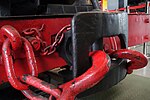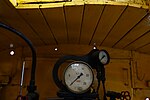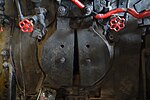
Under the Whyte notation for the classification of steam locomotives, 0-4-0 represents one of the simplest possible types, that with two axles and four coupled wheels, all of which are driven. The wheels on the earliest four-coupled locomotives were connected by a single gear wheel, but from 1825 the wheels were usually connected with coupling rods to form a single driven set.

0-6-0 is the Whyte notation designation for steam locomotives with a wheel arrangement of no leading wheels, six powered and coupled driving wheels on three axles, and no trailing wheels. Historically, this was the most common wheel arrangement used on both tender and tank locomotives in versions with both inside and outside cylinders.
Under the Whyte notation for the classification of steam locomotives, 2-10-2 represents the wheel arrangement of two leading wheels, ten powered and coupled driving wheels, and two trailing wheels. In the United States and elsewhere the 2-10-2 is known as the Santa Fe type, after the Atchison, Topeka and Santa Fe Railway that first used the type in 1903.

4-4-0 is a locomotive type with a classification that uses the Whyte notation for the classification of steam locomotives by wheel arrangement and represents the arrangement: four leading wheels on two axles, four powered and coupled driving wheels on two axles, and a lack of trailing wheels. Due to the large number of the type that were produced and used in the United States, the 4-4-0 is most commonly known as the "American" or "Eight-Wheeler" type, but the type subsequently also became popular in the United Kingdom, where large numbers were produced.

A 4-6-0 steam locomotive, under the Whyte notation for the classification of steam locomotives by wheel arrangement, has four leading wheels on two axles in a leading bogie and six powered and coupled driving wheels on three axles with the absence of trailing wheels.
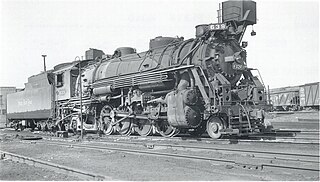
Under the Whyte notation for the classification of steam locomotives, 2-8-2 represents the wheel arrangement of two leading wheels on one axle, usually in a leading truck, eight powered and coupled driving wheels on four axles and two trailing wheels on one axle, usually in a trailing truck. This configuration of steam locomotive is most often referred to as a Mikado, frequently shortened to Mike.

Under the Whyte notation for the classification of steam locomotives, 0-10-0 represents the wheel arrangement of no leading wheels, ten powered and coupled driving wheels on five axles and no trailing wheels. In the United Kingdom, this type is known as a Decapod, a name which is applied to 2-10-0 types in the United States. In the United States, the type is known as ten-coupled.

Under the Whyte notation for the classification of steam locomotives, a 2-6-4 locomotive has two leading wheels, six coupled driving wheels and four trailing wheels.
Under the Whyte notation for the classification of steam locomotives, 0-8-0 represents the wheel arrangement of no leading wheels, eight powered and coupled driving wheels on four axles and no trailing wheels. Locomotives of this type are also referred to as eight coupled.
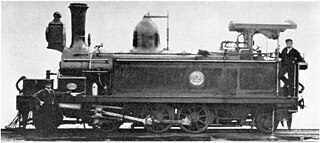
Under the Whyte notation for the classification of steam locomotives, 2-6-2 represents the wheel arrangement of two leading wheels, six coupled driving wheels and two trailing wheels. This arrangement is commonly called a Prairie.
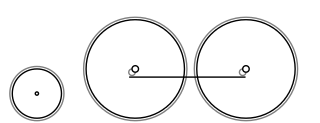
Under the Whyte notation for the classification of steam locomotives, 2-4-0 represents the wheel arrangement of two leading wheels on one axle, four powered and coupled driving wheels on two axles and no trailing wheels. In most of North America it became known as a Porter.

Under the Whyte notation for the classification of steam locomotives, 0-4-2 represents the wheel arrangement with no leading wheels, four powered and coupled driving wheels on two axles and two trailing wheels on one axle. While the first locomotives of this wheel arrangement were tender engines, the configuration was later often used for tank engines, which is noted by adding letter suffixes to the configuration, such as 0-4-2T for a conventional side-tank locomotive, 0-4-2ST for a saddle-tank locomotive, 0-4-2WT for a well-tank locomotive and 0-4-2RT for a rack-equipped tank locomotive.
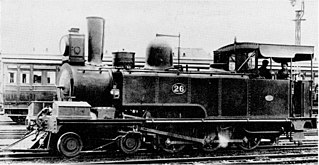
The South African Railways Class C 4-6-0T of 1879 was a steam locomotive from the pre-Union era in the Colony of Natal.

The Class 9600 (9600形) is a type of 2-8-0 steam locomotive built by Japanese Government Railways from 1913. The Class 9600 was the first type of locomotive to be mass-produced by Japanese manufacturers. The Class 9600 were popularly known as Kyuroku (nine-six), and were extensively used for freight service throughout Japan.
They were numbered 9600-9699, 19600-19699, 29600-29699, 39600-39699, 49600-49699, 59600-59699, 69600-69699 and 79600-79669. All 770 remained in service until the 2nd of March 1976, when all steam-hauled service on JNR's network has been phased out.

The Natal Government Railways Class I 2-6-0 of 1902 was a South African steam locomotive from the pre-Union era in the Colony of Natal.
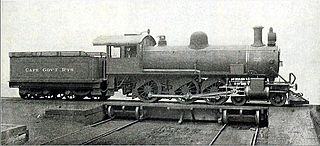
The South African type WE tender was a steam locomotive tender from the pre-Union era in the Cape of Good Hope.

The South African type WG tender was a steam locomotive tender from the pre-Union era in the Cape of Good Hope.
Caoba–Guanjiashan railway, or Caoguan railway is a short 1,000 mm railway in Yunnan Province of China, a branch of the 1,000 mm (metre-gauge) Kunming–Hekou railway. It is 31.9 km long. It connects Caoba station on the Kunming–Hekou railway with Guanjiashan railway station, a dead-end station in Datun Town of Gejiu City. It also serves as the connector between the Kunming–Hekou railway and the Mengzi–Baoxiu railway.

Four South Australian Railways L class broad-gauge locomotives with a 4-4-0 wheel arrangement were built by Beyer, Peacock and Company in 1879 and entered service in March–April 1880. They were condemned in 1928 and 1931, and were subsequently scrapped.


